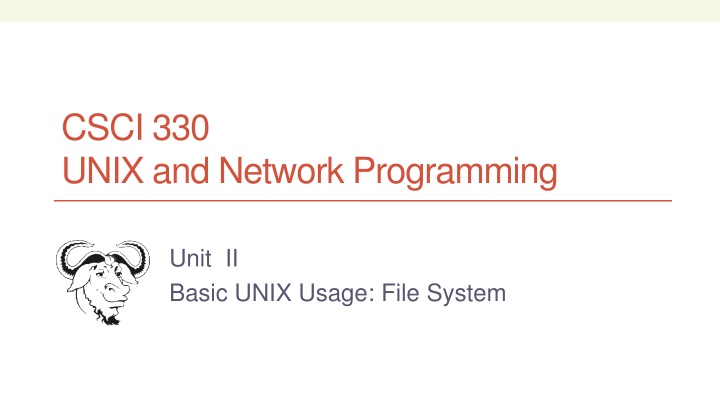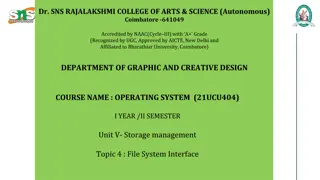Introduction to Basic UNIX Usage and Network Programming
In this course, you will learn the fundamentals of UNIX usage and network programming. Topics covered include basic UNIX commands, file system structure, UNIX shell functionalities, command line structure, and essential commands like passwd, ls, more, logout, date, and man. Understanding the hierarchical organization of the Unix file system, interpreting and executing commands in the terminal, and utilizing the man command for system manual pages are key components of this course.
Download Presentation

Please find below an Image/Link to download the presentation.
The content on the website is provided AS IS for your information and personal use only. It may not be sold, licensed, or shared on other websites without obtaining consent from the author.If you encounter any issues during the download, it is possible that the publisher has removed the file from their server.
You are allowed to download the files provided on this website for personal or commercial use, subject to the condition that they are used lawfully. All files are the property of their respective owners.
The content on the website is provided AS IS for your information and personal use only. It may not be sold, licensed, or shared on other websites without obtaining consent from the author.
E N D
Presentation Transcript
CSCI 330 UNIX and Network Programming Unit II Basic UNIX Usage: File System
CSCI 330 - UNIX and Network Programming 2 UNIX Shell: traditional user interface in the terminal at the command line via Terminal Emulator via putty Features: interprets and executes commands remembers command history and allows editing allows command submission as background jobs
CSCI 330 - UNIX and Network Programming 3 Command Line Structure % command [-options] [arguments] Arguments can be: 1. names of files 2. more information Command prompt Command name Command modifier: usually one character preceded by + or - sign UNIX is case sensitive Must be a space between command, options and arguments No space between the plus or minus sign and option letter Fields enclosed in [ ] are optional
CSCI 330 - UNIX and Network Programming 4 Command Line Example % sort list % sort -r list % sort -o sorted list Command argument Command option Command name Option argument
CSCI 330 - UNIX and Network Programming 5 Some Basic Commands passwd - change password ls - list files more - show content of file, page by page logout - logout from system date who clear - display date and time - display who is on the system - clear terminal screen man - find and display system manual pages
CSCI 330 - UNIX and Network Programming 6 RTFM: The man Command show pages from system manual Syntax: man [options] [-S section] command-name % man date % man -k date % man crontab % man -S 5 crontab Section Description 1 User commands 2 System calls 3 C library functions 4 Special system files Caveats: 5 File formats Some commands are aliases Some commands are part of shell 6 Games 7 8 Miscellaneous features System administration utilities
CSCI 330 - UNIX and Network Programming 7 The Unix file system hierarchical organization of files contains directories and files always single tree basic commands to list and manipulate files independent of physical file system organization typical Unix file system types ext4 (formerly ext2, ext3) Reiser4, UFS ( HFS+), JFS, also: vfat, ntfs
CSCI 330 - UNIX and Network Programming 8 Directory terminology Root Directory: / top-most directory in any UNIX file structure Home Directory: ~ directory owned by a user default location when user logs in Current Directory: . default location for working with files Parent Directory: .. directory immediately above the current directory
CSCI 330 - UNIX and Network Programming 9 Path path: list of names separated by / Absolute Path Traces a path from root to a file or a directory Always begins with the root (/) directory Example: /home/student/Desktop/assign1.txt Relative Path Traces a path from the current directory No initial forward slash (/) dot (.) refers to current directory two dots (..) refers to one level up in directory hierarchy Example: Desktop/assign1.txt
CSCI 330 - UNIX and Network Programming 10 Path to file3 Absolute Path: /usr/staff/joan/file3
CSCI 330 - UNIX and Network Programming 11 Directory commands pwd cd to show path of current working directory to change the current working directory mkdir to create a new directory rmdir use rm -r to remove non-empty directory to delete an empty directory
CSCI 330 - UNIX and Network Programming 12 List directory content most frequently used file system command: Syntax: ls [options] [path] common options: -a show all files -l show long version of listing -t show files sorted by time stamp -S show files sorted by file size -r show files in reverse sorted order
CSCI 330 - UNIX and Network Programming 13 Long List Option List contents of the current directory in long format % ls -al total 126 drwxr-xr-x 13 ege csci 1024 Apr 26 15:49 . drwxr-xr-x 15 root root 512 Apr 24 15:18 .. -rwxr--r-- 1 ege csci 885 Dec 2 13:07 .login -rwx------ 1 ege csci 436 Apr 12 11:59 .profile drwx------ 7 ege csci 512 May 17 14:11 330 drwx------ 3 ege csci 512 Mar 19 13:31 467 drwx------ 2 ege csci 512 Mar 31 10:16 Data -rw-r--r-- 1 ege csci 80 Feb 27 12:23 quiz.txt . is current directory .. is parent directory dot (.) names are hidden files directories plain file
CSCI 330 - UNIX and Network Programming 14 File System Commands Copying files or directories Syntax: cp source(s) target source(s) is one or more items to copy target is either name of copied item, or directory commonly used options: -iif target exists, then prompts for confirmation before overwriting -r recursively copy entire directories -p preserve access times and permission modes Moving files or directories Syntax: mv source(s) target
CSCI 330 - UNIX and Network Programming 15 Renaming files or directories use mv Example: rename file unix to csci330 % mv unix csci330 Caveat: what happens if csci330 exists and is a directory ?
CSCI 330 - UNIX and Network Programming 16 Deleting files or directories Syntax: rm path-list Commonly used options: -f force remove regardless of permissions -i prompt for confirmation before removing -r removes everything under the indicated directory Example: remove file old-assign % rm unix/assign/old-assign
CSCI 330 - UNIX and Network Programming 17 Linking Files Allows one file to be known by different names Link is a reference to a file stored elsewhere 2 types: Hard link (default) Symbolic link (a.k.a. soft link ) Syntax: ln [-s] target local
CSCI 330 - UNIX and Network Programming 18 Link illustration home create entry bb in dir3 as link to file aa in dir1 student dir1 dir2 aa dir3 % cd /home/student/dir2/dir3 % ln /home/student/dir1/aa bb bb
CSCI 330 - UNIX and Network Programming 19 File System Layout file consists of: data blocks: identified by block numbers file meta information: inode contains which blocks make up file, owner, permissions, etc. stored in inode table index into table is inode number directory is table of: file name -> inode number
CSCI 330 - UNIX and Network Programming 20 Hard Link example: ln Contents of dir1 inode table . 1076 . home 2406 2407 2408 . . 2083 .. aa student 2407 dir1 dir2 disk blocks file data Contents of dir3 aa dir3 1070 . bb 2050 .. bb 2407
CSCI 330 - UNIX and Network Programming 21 Symbolic Link example: ln -s Contents of dir1 inode table . 1076 . home 2598 2599 2600 . . 2083 .. aa student 2407 dir1 dir2 disk blocks Contents of dir3 aa dir3 1070 . bb 2050 .. bb 2599
CSCI 330 - UNIX and Network Programming 22 Link type comparison Hard Link Checks for the existence of the original file The original file continues to exist as long as at least one directory contains it Symbolic Link Created without checking the existence of the original file Cannot access the original file if its path has restricted permissions Can cross physical file systems Cannot link to a file in a different file system Can be circular linked to another symbolic linked file
CSCI 330 - UNIX and Network Programming 23 Locating Files: find Syntax: find path-list expression(s) find recursively descends through directories in path-list and applies expression to every file Examples: find . -name *.txt find /tmp -empty -delete
CSCI 330 - UNIX and Network Programming 24 Many more commands touch cat more, less or pg display the contents of file(s) one page at a time Space bar to advance to next page b to go back a page Enter Key to advance to next line updates time stamp on file or directory can be used to create new, empty file displays content of file(s)
CSCI 330 - UNIX and Network Programming 25 more commands head displays the beginning portion of indicated file(s); the default head size is 10 lines. tail displays the ending portion of indicated file(s) wc display the size of files common options: -l display the number of lines -w display the number of words -c display the number of characters
CSCI 330 - UNIX and Network Programming 26 Comparing Files: diff compare two files line by line Syntax: diff [options] file-1 file-2 reports a series of commands that can be used to convert the first file to the second file via the patch command
CSCI 330 - UNIX and Network Programming 27 Compress File Contents utilities to compress and uncompress files common on Linux: gzip, gunzip, zcat file extension: Example: % gzip assign1.txt % zcat assign1.txt.gz % gunzip assign1.txt.gz Also: bzip2 Windows compatible: .gz better compression zip/unzip
CSCI 330 - UNIX and Network Programming 28 Sorting Files Syntax: sort [options] file-name Commonly used options: -r sort in reverse order -n numeric sort -t field delimiter (default: blank) -k field1[,field2] -f ignore case
CSCI 330 - UNIX and Network Programming 29 User s Disk Quota quota is upper limit of amount disk space number of files for each user account 2 kinds of limits: Soft limit: ex. 100MB Maybe exceeded for one week System will nag Hard limit: ex. 120MB Cannot be exceeded command: quota -v displays the user s disk usage and limits
CSCI 330 - UNIX and Network Programming 30 Sending Files to the Printer Syntax: lpr [options] file option P to specify printer: lpcsl (others: lpfrl) Example: % lpr P lpcsl assign1.cc other commands: lpq show print job queue lprm remove job from queue
CSCI 330 - UNIX and Network Programming 31 Summary shell is traditional command line user interface hierarchical organization of files basic commands to list and manipulate files























